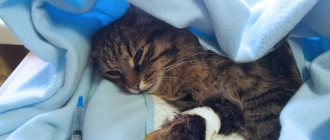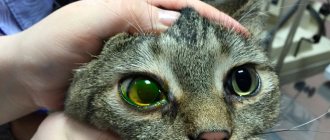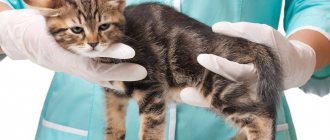Feline leukemia is one of the most dangerous incurable retroviral diseases of cats, which is dormant (hidden, sluggish) and does not manifest itself until the beginning of the terminal phase. Together with infectious peritonitis and immunodeficiency in cats, leukemia is included in the ominous list of “tri-fatal” infections, characterized by high contagiousness and lethality.
Other names for leukemia in cats are VLK, FeLV, blood cancer, leukemia, viral leukemia, Leucaemia viralis, lymphosarcoma, hemoblastosis.
Why is it dangerous to neglect treatment for leukemia?
Lack of treatment is fraught with the development of the disease and its accompanying pathologies, which lead to death. An animal that does not receive veterinary care develops:
- anemia;
- spontaneous bleeding;
- chronic cystitis;
- constant low-grade fever;
- bacterial infections;
- viral respiratory diseases;
- peritonitis;
- ascites;
- toxoplasmosis;
- autoimmune glomerulonephritis;
- stillbirth;
- damage to the mammary glands in females;
- miscarriages;
- fetal resorption and fading kitten syndrome;
- sarcoma of the lymphatic system.
A pregnant cat with leukemia will give birth to already infected kittens, which usually do not survive due to the body’s lack of strength to fight the virus. Therefore, cattery owners should definitely examine their cats.
What is leukemia
When considering various methods of treating leukemia, it is worth first understanding what kind of pathology it is and what its danger is. Leukemia, also often called leukemia, is a viral pathological process during which the formation of a large number of young leukocytes with an immature structure in the blood is noted.
It is worth noting! Viral leukemia in cats is caused by an RNA virus. It belongs to the genus of oncoviruses from the retrovirus family.
Leukemia usually has a chronic course. This disease manifests itself in the form of a weakened immune system, liver and kidney diseases, anemia, peritonitis, ascites, leukemia provokes the development of damage to the mammary glands in females.
Leukemia can occur in all cats, and it does not matter the type of breed, age or physiological state of the animal.
Increased sensitivity to RNA viruses is observed in kittens and young animals, as well as in animals with weakened immune systems.
Sometimes during the acute course of the disease, animals can die at the age of 3-4 years. To prevent infection, it is recommended that kittens be vaccinated.
Which cats can get leukemia?
All cats are at risk. Stray animals, domestic animals, young and old, purebred and mixed-breed animals are susceptible to the disease.
Why, then, are they not all carriers of the virus? The fact is that the virus is quite unstable to external influences. In the external environment, it most often dies within a couple of days. It is dangerous from sunlight, ultraviolet rays, low and high temperatures. It is vulnerable to disinfectants and alcohol-containing products. Nevertheless, it is incorrect to even talk about the relative safety of animals.
Reference! Cats, due to their lifestyle, are more often susceptible to the disease (fights, including for the right to mate with a cat in heat).
Methods of transmission of the virus
The virus is highly contagious - the ability of the infection to be transmitted from sick animals to healthy ones. It is transmitted from a sick animal to a healthy one under the following conditions:
- contact with the host’s saliva, urine, feces, or secretions from his nose or eyes;
- biting during a fight or play;
- through shared dishes, toys, beds;
- sexually;
- in utero from mother to kittens (as a rule, such babies do not survive);
- through flea bites;
- at an exhibition when using common things or being close to a sick colleague;
- after the owner visits the house where the leukemic cat lives, or a shelter, without changing clothes;
- in a clinic where instruments and tables are not thoroughly sanitized after each patient.
The greatest prevalence of hemoblastosis is observed in crowded cat prides, in so-called granny apartments, in shelters, as well as in basements where homeless individuals live.
Detailed lecture from a veterinarian about leukemia in cats:
Stages and warning symptoms
Asthma in cats and its symptoms are a fairly common allergic airway syndrome.
Epilepsy in cats: symptoms, treatment, how to stop seizures
The main symptoms include pulmonary constriction and increased mucus production, leading to inflammatory changes. The cat begins to cough frequently. Just like in humans, a cat's cough comes in many forms: it can be wet, dry, wheezing, or vomiting. This is a reflex reaction to irritation of the nerve endings in the mucous membrane of the upper respiratory tract.
Important! Cough accompanies various, more or less serious diseases, so it cannot be ignored and your pet must be shown to a doctor.
The main symptoms of asthma in a cat:
- restless behavior, rushing from corner to corner;
- characteristic posture during an attack: bent paws, lowered head, heavy breathing with an open mouth;
- sudden attack of suffocation;
- hacking cough;
- wheezing with whistling;
- fatigue after an attack, lethargy.
The main stages of feline asthma are shown in the table.
| Stage | Characteristic |
| Soft | · rare attacks; Duration of attack is less than 1 minute; · the animal quickly recovers after an attack. |
| Middle | · attacks are rare; The attack is accompanied by severe symptoms. |
| Heavy | · attacks are life-threatening; The cat may suffocate and die. |
The owner’s task is to prevent the disease from progressing from an early stage to a more severe form.
What causes the development of leukemia and what is its danger
The causative agent of the disease is an RNA-containing oncogenic retrovirus, which invades blood cells and destroys their genetic code. The Latin name is Feline leukemia virus. It was identified by scientists in Glasgow in 1964. Scientists have established a connection between cases of cancer of the blood and lymphatic system in cats with the detection of strains of this virus in their blood.
The virus is dangerous due to its oncogenicity and changes in blood composition, reducing the resistance of the cat’s body, and provoking secondary diseases. It begins its activity in the tonsils and lymphatic tissues of the nasopharynx, gradually spreading to the lymph, circulatory system, and brain.
Immune deficiency increases unnoticed. When the process spreads to the bone marrow, it is too late to fight, since the affected bone marrow produces more and more replicas of the virus along with blood cells, and leukocytosis progresses. Death usually occurs from diseases associated with hemoblastosis.
Symptoms of leukemia in cats
The disease is insidious in that it does not appear immediately, but when the number of leukocytes in the blood exceeds acceptable limits. In this case, helping your pet is very difficult, if possible at all.
Therefore, it is necessary to show your furry puppy to the veterinarian twice a year so as not to miss the first symptoms of the disease.
VLK in cats manifests itself with the following symptoms:
- drowsiness;
- lack of interest in games;
- frequent rises in temperature;
- loss of appetite;
- lethargy;
- salivation;
- frequent colds, cystitis;
- digestive problems;
- enlarged lymph nodes;
- discharge from the eyes and nose;
- bulging eyes;
- pallor of mucous membranes.
The symptoms are nonspecific, and the owner will not be able to independently figure out what is bothering his pet. By self-medicating, you can waste time and ultimately lose your pet.
How does feline leukemia manifest?
The decrease in the immunity of infected animals occurs gradually and asymptomatically.
Cat owners may not realize for years that their pet is dangerously ill.
Clinical signs of leukemia in cats do not appear immediately; they are diverse and resemble other pathological conditions.
Symptoms of viral leukemia:
- Weakness, increased fatigue, drowsiness;
- Lethargy, refusal of active games with the owner and relatives.
- Frequent long-term diseases of viral and bacterial nature. Relapses.
- Loss of appetite, exhaustion, refusal to eat.
- Enlarged and painful lymph nodes.
- Frequent alternation of periods of excitement with a depressed state.
- Fever. Increased body temperature above 40°C.
- Anemia.
- Pale mucous membranes.
- Jaundice.
- Gastrointestinal disorders: diarrhea, nausea, vomiting.
- Deterioration of coat condition, loss of shine.
- Difficulty breathing, shortness of breath.
- Loss of coordination of movements, muscle spasms.
- Increased salivation, stomatitis.
- Purulent discharge from the nose and eyes.
- Convulsions, seizures, fainting.
- Anisocoria – different pupil sizes.
- Reproductive problems: infertility, miscarriages.
- Tachycardia.
- Swelling of the limbs.
Important!
This dangerous disease can only be diagnosed in a clinic based on the results of laboratory tests. Don't put off visiting the veterinarian!
Life expectancy of a cat after infection
How long a cat can live after contracting viral leukemia depends on its immunity. Typically, it takes 3 to 10 years from infection to death. The incubation period ranges from four days to eight months.
Unfortunately, 90% of infected animals die in the 4th year of the disease. This high mortality rate is due to the fact that obvious symptoms appear 3 years after the cat is infected.
With good care, the animal remains a carrier of the infection for a long time, but does not get sick, and clinical signs of the virus do not appear. However, carrying the virus poses a danger to other cats.
Spread of the disease
Viral leukemia is one of the factors responsible for the high mortality rate among cats. This animal species is at risk of developing many serious diseases. They may develop cancer and anemia. Experts say that most cats die after infection after 3-4 years.
An infected cat becomes a source of disease among other animals. The infection can spread through saliva, feces, urine, and milk. However, the virus cannot survive in the environment. Infection is possible only through close contact between animals.
It is known that viruses spread most actively during prolonged interaction between animals. Infection can occur through sexual contact and feeding from the same container. It is believed that the most common method of transmission of the disease is a bite. In this case, the virus enters directly into the blood. If you are sure that your pet has not left his home, has not walked outside or interacted with other people’s cats, but the symptoms are very similar to those we described above, you don’t have to worry too much: he is unlikely to have feline viral leukemia. Diagnosis, according to specialists from veterinary clinics, should be carried out if the pet has been in contact with a sick animal for a long time.
Can a person get infected from a cat?
Numerous studies prove that it is impossible to become infected with leukemia from cats . In the human body there is nothing for it to “catch onto”, since the DNA of a cat and a person do not have identical areas vulnerable to the virus. In addition, human leukemia has a completely different, non-viral nature.
Feline leukemia is not dangerous for dogs either.
Therefore, you should not be afraid to take such an animal into your home as your only pet or in the company of a carrier of the same virus.
Types and forms of leukemia
An animal may have one or more retrovirus strains: A, B, C or T.
Depending on the state of immunity, leukemia in cats can occur in several forms:
- Transient (temporary). The initial period of the disease, until leukemia affects the bone marrow. At this stage, in rare cases, a strong immune system can develop a powerful response and destroy the pathogen completely. Such an animal receives lifelong immunity against viral leukemia. Typically, no more than two months pass from the onset of the disease, and these cats do not become a source of danger to others.
- Latent . This variety can occur when the immune system is strong. Replications of the virus are already present in the tissue structure, but the infection cannot multiply and become active. The animal remains a carrier, it may feel great, however, it poses a danger to healthy fellow tribesmen.
- A persistent or replication form of a viral organism. The weakened immune system no longer resists the penetration of the virus into the bone marrow structure. Signs of leukemia increase, primarily anemia. Particular harm is caused to the gastrointestinal tract, skin, bladder, and respiratory system.
Leukemia can be differentiated by type of localization:
- Thoracic leukemia is characterized by the accumulation of fluid in the chest area, due to which the animal becomes increasingly suffocated. Differential analysis with the wet form of viral peritonitis is required due to the similarity of symptoms;
- abdominal is characterized by damage to the gastrointestinal tract and resembles an intestinal disorder or jaundice; constipation, dehydration, and cachexia also develop;
- multifocal affects several organs at once and has a very poor prognosis due to the difficulty of diagnosis.
Danger of disease
The danger of leukemia in cats lies in the aggressive development and growth of malignant cells. There have been cases of kittens dying a few days after birth, and these cases are not uncommon, since kittens are born “sterile” and do not have a strong immune system that can fight this virus.
There are also cases when kittens survive, and this virus lives quietly in their body, but does not manifest itself in any way. Viral leukemia can only be transmitted to cats; this disease cannot affect any other animals.
The virus is safe for people, which means it is not transmitted to humans. Cats of different breeds, species and ages are susceptible. The infectious disease in cats is very severe. The disease is not diagnosed immediately because the symptoms are general. Survival rate is low, within 15%.
NOTE! The more vigilant the owner is, the greater the chance of survival!
Diagnostics
In order to confirm or exclude viral leukemia, and if confirmed, determine its type and form, the veterinarian performs a series of tests:
- clinical blood test - to determine the level of leukocytes in the blood, erythrocyte sedimentation rate, the presence of anemia;
- PCR - polymerase chain reaction - study of peripheral blood;
- immunofluorescence blood test , which allows you to detect antibodies to the virus and determine its type;
- ELISA is an enzyme-linked immunosorbent assay that detects the presence of antibodies and antigens to the virus in the blood.
Attention! If, while symptoms persist, all tests for VLK are negative, it is too early to calm down. It is necessary to retake them after three months and conduct a differentiated study, since the same symptoms may indicate completely different diseases.
Today, veterinary clinics are increasingly doing rapid tests for leukemia ; they provide a high degree of reliability, but it is better to play it safe and conduct a comprehensive analysis.
It also doesn’t hurt to conduct ultrasound and x-ray studies, which can help identify the presence of malignant neoplasms and see abnormalities in the functioning of internal organs.
In some cases, the following are recommended for diagnosis:
- biopsy;
- colonoscopy;
- gastroscopy;
- laparoscopy.
These are invasive or minimally invasive tests and are done under general or local anesthesia.
Consequences of infection with feline leukemia virus
The disease is practically incurable.
As a result of infection, the following changes occur in the body:
- weakened immunity, which provokes a variety of pathologies;
- a quarter of animals develop anemia;
- neoplasia;
- skin diseases and pathologies of the reproductive system.
As a result of persistent struggle, the animal most often dies within 4-5 years. In most cases from secondary diseases.
Therefore, it is important to ensure that the cat does not become infected.
To do this, vaccinate your cat annually, limit contact with unknown cats and cats, and regularly undergo a rapid test for leukemia.
Treatment of viral leukemia
It is not yet possible to completely cure a cat from leukemia. But timely symptomatic therapy will significantly alleviate the pet’s condition and prolong its life. The selection of drugs is carried out by a veterinarian strictly individually, depending on the condition, tests and symptoms of the patient.
Modern veterinary science suggests acting in two directions in cases of deteriorating health:
- Stimulation and strengthening of the animal's immunity . The following proven drugs are used:
- Raltegravir.
- Feliferon.
- Interferon.
- AZT.
Antibiotics and vitamin complexes are also used.
- Symptomatic therapy:
- with the help of medications, symptoms of diseases developing due to decreased immunity and inhibition of hematopoiesis are relieved;
- a good but temporary effect is achieved by blood transfusion , this procedure will have to be repeated every 2 weeks; if oncology is diagnosed, chemotherapy (in particular, Vincristine), usually in this way it is possible to stop the pathological process.
In addition, owners will have to reconsider their approach to feeding their pet. Food must be complete and of high quality, heat-treated to prevent germs, bacteria and other pathogens from entering the weakened body of a pet.
A cat diagnosed with viral leukemia will have to be kept in quarantine for life , contact with other cats must be prevented, and its bed, dishes, toys, and litter tray must be kept clean. If there are other cats in the house, then after contact with the carrier you need to thoroughly wash your hands and, if possible, change clothes. It is useful to regularly quartz the room in which the carrier cat lives (during quartzing, the animal must be removed from the room).
Important! Remember that euthanizing a cat is a last resort. Never give up in the fight against the disease, even without resorting to treatment.
Treatment and relief of asthma attacks
Symptoms and treatment of asthma in cats depend on the type and severity of the disease.
Piroplasmosis in cats: symptoms and treatment
Treatment involves the medicinal option of using tablets and drugs. Surgical intervention is not applicable in this case.
Basics of treating asthma in cats:
- the treatment regimen and prescribed medications depend on the stage of the disease and symptoms;
- treatment is complex;
- The basis of therapy is dilating drugs in the form of an aerosol and are intended to stop an attack;
- it is possible to use hormonal drugs to treat inflammatory processes in the respiratory tract;
- sometimes antibiotic drugs are prescribed;
- It is important to use vitamin complexes to maintain immunity.
Possible options for hormonal drugs intended to treat a sick animal:
- pills;
- injections;
- aerosol.
Important! It is possible to use all three types of medications at the same time on the recommendation of a doctor. It all depends on the stage and severity of the disease.
The table below shows the advantages and disadvantages of using different forms of treatment:
| Form | Advantages | Flaws |
| Pills | Easier to use at home. The therapeutic effect is long-lasting. | The therapeutic effect takes only an hour. |
| Injections | They quickly enter the body and act instantly. You can install it right away. | Difficult to use at home. |
| Aerosols | Convenient to use. Local action, that is, it does not affect other organs. | Slow cumulative effect. The effect appears after two to three weeks. |
Treatment of asthma in cats should be carried out in a clinical setting
Prevention
You should not allow your pet to come into contact with stray and unexamined fellow pets, place it in dubious pet hotels and in unverified foster care, or use other people’s toys, trays, treats, food, bowls, beds, or medicines.
After the death of the previous cat from leukemia, it is recommended to get a new companion no earlier than 2 days after the death of the sick cat and only after cleaning the apartment. It is better to purchase new bowls and trays.
But the best way to protect your pet from viral leukemia is timely vaccination , which must be preceded by a carrier test. Kittens are vaccinated at the age of 2 months and repeat this procedure annually. The vaccine does not kill the infection, but increases the body's resistance to the virus and has a cumulative effect. Therefore, it is important not to forget to vaccinate your pet.
Viral leukemia is one of the most dangerous pathologies in cats. The prognosis for the disease is unfavorable, but still, in our time, lymphosarcoma is not a death sentence, so it is important to recognize VLK at the initial stages of development using comprehensive diagnostics. A timely visit to a specialist will help improve the quality of life of your furry cat and extend his days. To prevent infection, it is necessary to follow preventive measures and pay attention to the general condition of the animal.











